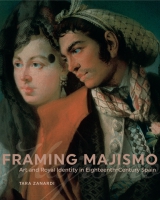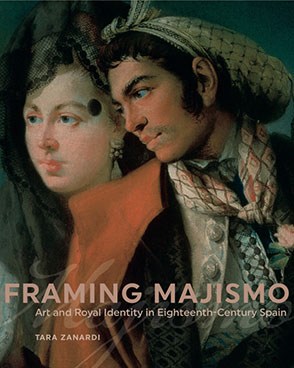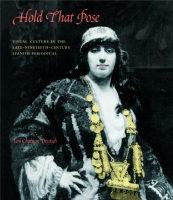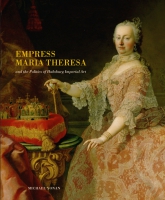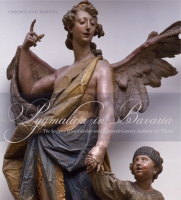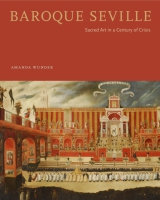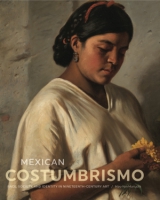Framing Majismo
Art and Royal Identity in Eighteenth-Century Spain
Tara Zanardi
“Zanardi convincingly shows that majismo’s ability to reflect the past as well as implicate the modern, and the way that it highlights the demonstrated importance of fashion and appearances in constructing national character, is of continued relevance today.”
- Description
- Reviews
- Bio
- Table of Contents
- Sample Chapters
- Subjects
In Framing Majismo, Tara Zanardi explores nobles’ fascination with and appropriation of the practices and types associated with majismo, as well as how this connection cultivated the formation of an elite Spanish identity in the late 1700s and aided the Bourbons’ objective to fashion themselves as the legitimate rulers of Spain. In particular, the book considers artistic and literary representations of the majo and the maja, purportedly native types who embodied and performed uniquely Spanish characteristics. Such visual examples of majismo emerge as critical and contentious sites for navigating eighteenth-century conceptions of gender, national character, and noble identity. Zanardi also examines how these bodies were contrasted with those regarded as “foreign,” finding that “foreign” and “national” bodies were frequently described and depicted in similar ways. She isolates and uncovers the nuances of bodily representation, ultimately showing how the body and the emergent nation were mutually constructed at a critical historical moment for both.
“Zanardi convincingly shows that majismo’s ability to reflect the past as well as implicate the modern, and the way that it highlights the demonstrated importance of fashion and appearances in constructing national character, is of continued relevance today.”
“Zanardi's study of majismo, a cultural phenomenon of later eighteenth-century Spain, is a welcome contribution to the literature in English. . . . The author reads the Spanish elite's embracing of majo culture through social performance and artistic patronage as a means of recuperating Spanish heritage and claiming native authenticity. Zanardi is rigorous in analyzing the ways in which visual art participated in and complicated this construction of national character. Through probing examination and theorizing of the clothing, class, body, and gender depicted in paintings, prints, and sculptures by Spanish and non-Spanish artists, the author challenges the unsteady binaries in majo representation—native and foreign, royalty and commoner, masculine and feminine, traditional and modern. Recommended.”
“Through a thorough and cogent analysis of multiple images of majas and majos by canonical artists from Goya to Picasso, in fashion catalogs, costumbrista illustrations, and tapestry cartoons, Tara Zanardi traces the cultural phenomenon of majismo among eighteenth-century Spanish elites, which came to be associated with ‘true’ Spanish identity into the twentieth century. Despite attempts to connect to Spanish tradition, majismo ultimately projected ambiguous national, gender, and class identities that can still be seen in Spain today.”
“What does it mean to be Spanish? And how did Spain come to differentiate itself from the rest of the world? These are questions that Tara Zanardi addresses in this insightful, perceptive study of majismo, the eighteenth-century movement to define uniquely Spanish cultural prototypes drawn from the urban lower classes of Madrid. Majismo codified costumes, behaviors, and practices now considered quintessentially Spanish, among them bullfighting and the wearing of the mantilla. Zanardi reveals the maja and majo to be ambiguous cultural figures, since in them were combined tradition and modernity, earthiness and elegance, chivalry and sass. Through detailed analysis of eighteenth- and early nineteenth-century imagery, including prints and paintings by Francisco Goya, Zanardi’s important book delves into the foundational myths of Spanishness itself.”
“Tara Zanardi’s Framing Majismo addresses ambitious questions about the role played by art in the formation of Spanish identity for the Bourbon monarchy during the Enlightenment and in the aftermath of the French Revolution. It is a work of admirable erudition and complexity, bringing together a broad range of sources—primary and secondary, historical and theoretical. A model of interdisciplinary research, Zanardi’s book has implications for eighteenth-century studies more generally—for people interested in monarchy, questions of identity, gender studies—and will generate a great deal of additional discussion and research, always the sign of a truly important publication. It stands as a defining study for art history of the period.”
Tara Zanardi is Assistant Professor of Art History at Hunter College.
Contents
List of Illustrations
Acknowledgments
Introduction
1 Majismo, the Spanish National Character, and the Elite Cultivation of Cultural Patrimony
2 Swaggering Majos: Performing the Masculine Ideal
3 Performing the Bullfight: Spanish Bodies as Noble Spectacle
4 Majas, Elites, and Female Agency
5 Majismo and Elite Identity
Conclusion
Notes
Bibliography
Index
Introduction
When my eldest sister, Stephanie, returned home from her semester abroad in Spain, I was just a little girl. She arrived armed with Christmas presents, most of which I do not recall. My gift was exquisitely wrapped. When I opened it, I found a Barbie-esque flamenco dancer whose voluminous flounced skirt and matching red bodice were flecked with gold and proudly displayed by her affected pose. While living in Madrid for doctoral research, I saw many such dolls lining souvenir shops. That this dancer kindled my interest in Spain is probable. What is more important, however, is that this type, the female flamenco dancer, is part of a constructed artistic vision of Spanishness that developed in the eighteenth century. The flamenco dancer is a recognizable icon of pictorial costumbrismo—the Romantic depiction of local customs and characters—from the nineteenth and twentieth centuries, as well as a familiar type associated with Spain whose dress and style have historical roots prior to 1800. Despite her current kitsch appeal as a mass-produced doll, the flamenco dancer is not the first type to embody purportedly customary Spanish traits.
Visual depictions of majos (fig. 1) and majas (fig. 2) from the eighteenth century—popular, urban, and plebeian characters regarded as quintessentially Spanish—confirm that the history of types who supposedly epitomize qualities deemed as traditional originated not in the 1800s, but earlier. These “Spanish” traits were based partially on Enlightenment understandings of national character and race. To account for differences among peoples, specific traits were affiliated with a particular group (or nationality or region of the globe) as part of the broader Enlightenment project of categorizing human variety. Majos and majas, the popular types who were associated with Spanish cities, primarily Madrid, and served as artisans and vendors, were often romanticized and given an affected regality in visual representations. Artists exaggerated their gestures, foregrounded their employment in local industries, and depicted them as active participants in traditional customs, ultimately making them models of an idealized notion of Spanishness.
<insert fig. 1 about here>
<insert fig. 2 about here>
The process by which majos and majas came to epitomize lo castizo (pure Spanishness) included their pictorial differentiation from those types representing the foreign, such as the petimetre and petimetra (figs. 3 and 4), who falsified a high social status, feigned cosmopolitan airs, and were the source of satire. Lo castizo was attributed to traditional customs and peoples, making the majo and maja the embodiment of customary values and practices. I use the terms “popular,” “traditional,” “customary,” and lo castizo interchangeably. These terms are not directly linked to nationalism, which is typically associated with the nineteenth century. In the 1700s, patriotic sentiment was often fueled by collective traits common to a specific group, based on Enlightenment ideas of national character. The idea of lo castizo did not necessarily exist across Spain, where regional identity prevailed, making the concept of “nationalism” problematic. Thus, I foreground the eighteenth-century nomenclature of national character instead of nationalism.
<insert fig. 3 about here>
<insert fig. 4 about here>
Visual representations of majos and majas, including paintings, tapestries, pastels, prints, and drawings, emphasize purportedly unique Spanish characteristics, often embodying but also confounding prevailing gender stereotypes based in part on eighteenth-century theories of pathognomy, physiognomy, and national character. By the end of the 1700s, gender difference was rooted in new perceptions of the body stemming from biological study; this further articulated separate spheres for men and women, generating a “two-sex” model, according to Thomas Laqueur. More recently, Erin M. Goss has addressed the issue of sexual differentiation. Similar to Laqueur, she argues that eighteenth- and nineteenth-century anatomical discourse and theories of physiology sought to establish fundamental distinctions between male and female bodies (by way of their skeletal and muscular structures) in order to “naturalize extant assumptions of the differences they claim to explain.” Recognizing the obvious differences between masculine and feminine, lo castizo and the foreign, popular and elite, and tradition and modernity, I believe that majos/as and other types were frequently described and depicted in similar ways, complicating the clear divisions they were meant to exemplify. Majos and majas simultaneously represented a link to the past and embodied contemporary Spain by honoring and renovating Spanish practices and by wearing supposedly traditional garb, often in conjunction with new trends. Many eighteenth-century Spaniards contested majos/as’ claims to authenticity, especially as elites appropriated the clothing and customs of popular types, obscuring class divisions and undermining expected aristocratic behavior. Artists visualized majos/as as incarnations of early modern Spanish nobility, through their somatic affectations and dress. Such reciprocity between elites and plebeians contributed to the blurring of social distinctions.
Majismo, a cultural phenomenon that embodied the popular aesthetic from the second half of the eighteenth century, was partially a xenophobic reaction to the perceived boost in outside influence on Spain, as well as a challenge to the progressive reforms instituted during the Enlightenment. More significantly, majismo served as a means to “regain” Spanish heritage, although debate over what constituted Spanish ancestry problematized the emphasis on authenticity, which majos and majas were supposed to embody. For example, in the Encyclopédie, a multivolume text published between 1751 and 1777, Denis Diderot commented on Spain’s heterogeneous past, listing the Romans, Goths, Vandals, and Arabs as important participants in the country’s development. The Encyclopédie aimed to encourage critical thought, and this collaborative effort made it a watershed work by the “men of letters” who characterized the Enlightenment. Spain’s multiethnic heritage further complicated claims that majos/as better personified the Spanish national character than their royal, “foreign” superiors (the Bourbons). Definitions of the Spanish national character varied, making evaluations of who embodied such qualities more difficult to assess. Imagining popular types as models of an authentic Spanishness, artists often portrayed them as the inheritors of Spain’s early modern heroes, highlighting their dress, their contributions to Spain’s economy as laborers, and their maintenance of customary practices, such as bullfighting and Spanish dances.
Majismo, as expressed via artistic means, conferred on Spanish “citizens” the pictorial ideal of a shared national character, regardless of the debate over what did or did not constitute Spain’s national character. The communal aspects of majismo are significant, including the celebration of traditional festivals, customs, and corresponding dress, as well as the championing of urban neighborhood pride and laboring artisans. Pictorial majismo helped forge a perception of a collective Spanishness. Artists depicted majos and majas wearing garments viewed as historically Spanish, performing as bullfighters, and contributing to national industries in their capacities as artisans or street vendors. Spanish elites’ appropriation of certain traditional attributes typified by majos/as solidified this invented “national spirit,” even if that spirit did not exist at the national level. Images devoted to themes of majos and majas contributed to the conceptualization of Spanishness by highlighting characteristics that were, in fact, rooted in collective climatic, religious, and cultural commonalities.
Visual examples of majismo and lo castizo often glorified urban laborers. Many of these images—in painting or decorative art form—were destined for an elite audience or for foreign consumption. Underscoring qualities deemed fundamentally Spanish, such images of types and traditional practices reinforced stereotypes with regard to the national character. However, majos and majas were predominantly associated with urban sites and were arguably not representative of all Spanish traits. In 1734, the Diccionario de la lengua castellana defined majos as “those who typically live in the outskirts of this Court,” referring to Madrid. The term majo could also be used to describe a person who “affects beauty and bravery in his actions and words,” pointing to majos’ position outside of official society and to their heightened affectation, in an effort to compensate for their “marginalized” status. Rebecca Haidt emphasizes that these outcasts could be “depicted as idlers, allies of criminals, underminers of law and order; or (as is often the case in sainetes and tonadillas) underprivileged people trying to keep their spirits up and their bellies full.” She also argues that these groups “became aestheticized through late eighteenth-century texts and images depicting them as emblematic of national character.” The aestheticization of types in visual works was particularly appropriate when the images were created for an elite audience, as romanticized versions were considered decorous. The discrepancies in differing accounts and characterizations of majos accentuated the problem faced by artists in the last half of the 1700s; types yielded myriad descriptions and affiliations—not one fixed definition. While artists codified traits to identify types, these qualities could also be reordered, complicating the means of recognizing such groups. Types were essentially unstable cultural and social tropes that could be manipulated to relay fears or express pride. This book seeks to isolate and uncover the nuances of their representation in order to propose that the visualization of types was a multifarious and challenging project undertaken at precisely the moment when definitions of national character and gender were shifting during the 1700s. Majismo offers a trove of popular imagery that points to underlying societal tensions between class and gender and between tradition and modernity.
My purpose is twofold. First, I aim to identify and interrogate pictorial constructions of gendered Spanishness in which stock figures were strategically used to convey Spanish elite identity and lo castizo. Second, I demonstrate the political and personal reasons for why elite patrons commissioned popular-themed objects and had their portraits painted wearing forms of traditional garb. Women were the active instigators in this sartorial trend and often used dress to challenge the hierarchies of gender. When considered thus, visual examples of majismo emerge as critical and often contentious sites for navigating eighteenth-century conceptions of gender, national character, and noble identity. Ultimately, I seek to understand how majismo recast the elite persona as Spanish, how it forged a novel sense of common identity that was equally grounded in tradition and conceived of as modern, and how it often mythologized lo castizo.
The visual richness of majismo was a vital ingredient in the overall shaping and expression of the phenomenon and warrants sustained study, so that majismo’s art historical component is given its due. By looking to pictorial constructions of the popular, I hope that my study enriches the overall conversation about majismo and also sheds new light on its understudied yet vibrant visual contribution, which merits its own analysis grounded in an art historical discipline and is embedded in the images’ complexity as works of art. Framing Majismo: Art and Royal Identity in Eighteenth-Century Spain attempts to extricate the discussion of the majo and maja from the restrictions placed on these types as purely “national,” partisan stereotypes, and to situate these stock figures within other, more productive frames of reference, including artistic ones. My book does not provide a comprehensive survey of the visual output of majismo. Instead, it considers certain images of popular types as exemplary of critical issues surrounding heightened national sentiment, the intellectual exploration of Spain’s history and culture, the elite fascination with the folk, and the upper-class appropriation of popular customs and dress as a vehicle for expressing Spanishness. This book is an inquiry into particular modes of elite fashioning via the popular type. I am also deliberately selective, singling out specific works and unraveling the ways in which Spanish noble identity can be located in them. By appropriating dress and the “performative” swagger of majos/as, the Bourbon royal family and other elites usurped the imagined associations of these types in order to suggest their “authenticity” as the legitimate rulers of Spain.
This book focuses on the “ennobling” of popular types by members of court, who saw them as a viable means of establishing themselves politically and socially as “Spanish.” Artists responded to the elite desire for supposedly traditional imagery but did not always follow standard visualizations (which they often helped codify). In fact, artists frequently subverted images of types to point to the types’ greater complexity; for instance, not all majos and majas who migrated to the capital originated from the same region, despite their proud identification with specific neighborhoods in Madrid, a topic that Haidt thoroughly investigates. Popular types and customs in fact encouraged artistic innovation, serving as thoroughly novel subjects that artists could explore in a diverse array of media—paralleling the varied characterizations of the types themselves, who are discussed here as figures tied to the past and as definitively modern. That elites identified with these lower-class types in works they commissioned or in portraits in which they dressed in customary garments complicates the broader meanings of majismo. My intention is that this study will encourage a reassessment of monarchical and elite imagery in Bourbon Spain and contribute a new model for evaluating majismo.
It is the pictorial relationship established between elites and the popular that anchors my book. This study is principally an inquiry into the upper-class fascination with and appropriation of the practices and types associated with majismo, and how this connection impacted the formation of a Spanish elite identity, especially during the reigns of Charles III (1759–88) and Charles IV (1789–1808). Thus, the images I have chosen assisted in mediating noble enthusiasm for castizo-themed objects. Not all Spanish aristocrats or members of the upper bourgeoisie showed interest in popular types and customs, nor do all visual manifestations of majismo relate to the fashioning of elite identities. Since my study primarily concerns the artistic depiction of popular types and elite identity formation via these figures, I foreground discussions of majismo that pertain to the understanding of how this phenomenon was manipulated by people concerned not with the daily plight of urban laborers, but with their symbolic value. Although evaluating the pictorial expressions of majismo from a socioeconomic perspective would make for a compelling book, it is beyond the scope of this study. I do examine, however, the ways in which labor issues and the socioeconomic circumstances of the actual urban poor made a vital impact on many of the images I discuss, especially since majos/as supported themselves as factory workers, as unskilled laborers, or as street vendors. Although artists sometimes portrayed majos/as at work, they also represented them at play—engaged in time-honored customs—and in confrontations. Such diversity in the depiction of majos/as indicates their disparate meanings and associations.
Since much of my discussion hinges on imagery commissioned by an elite audience and made by artists trained in the Real Academia de Bellas Artes de San Fernando (hereafter RABASF), I highlight an aristocratic patronage system and an academic milieu. Even artists engaged in creating costume albums and fashion plates that circulated popularly were academically trained. For example, Juan de la Cruz y Holmedilla studied in Paris in order to learn the latest printmaking techniques. Although many of the images in print form were consumed by the middle classes or viewed by all, the artistic context for the crafting of the images I examine favors a knowledgeable and upper-class public. Such privileging, from the works’ origins to their destinations, underscores their role in the formation of a Spanish elite identity and the construction of a pictorial ideal of Spanishness that benefited members of court.
With the French Revolution and subsequent political upheavals and wars in the 1790s and early 1800s, the potential questioning of monarchical divine right spurred Spanish royals to fashion themselves as patriots for their own political gain and to separate themselves from the French Bourbons, with whom they shared familial bonds. By commissioning artists to depict popular subjects in various media for their homes and by dressing in traditional garments associated with majos and majas in their portraits, aristocrats and the upper bourgeoisie could manipulate to their advantage the fashionability of types and their purportedly “indigenous” heritage—which elites could not always rightly claim, since many of them descended from Italian or French lineages. Portraiture was a particularly useful method of crafting elite identity, but the portrait’s limited audience and private display often made it an object for privileged consumption, not for a general audience. Although Spain’s RABASF maintained an unjuried annual exhibition from 1793 to 1808, which functioned as a public forum for presenting works of art, these shows were much smaller in scale than their juried French counterpart. Unless artists had prints made after their paintings to distribute among a wider audience, many of the objects representing popular themes were not seen by the public. In addition, many of the royal factories—glass, porcelain, and tapestry—almost exclusively produced their wares for aristocratic consumption. Such a restricted group of buyers played a key role in image construction; when artists supplied designs for the manufacture of decorative objects or created single works, such as portraits, for elite residences, the theme of majismo had a clear bent toward noble use and had vital political meaning for the patrons. The works’ application in the fashioning of elite identity for political or personal purposes, therefore, has significant ramifications for my investigation of the pictorial manifestations of majismo.
The absence of a lengthy art historical bibliography on majismo necessitates an interdisciplinary approach and a scholarly foundation consisting of material culture, literary history, and kingship and queenship studies. My book is the first to foreground majismo as a major subject for artists, and it examines many of their works (some familiar, some not) in novel ways. Thus, I seek to enliven the debate on majismo from an art historical perspective. Such artistic depictions do require cross-disciplinary connections. But, as an art historian, I highlight the images, which merit their own contextualized investigation, since artistic representations exist not only in the larger cultural expressions of a phenomenon but also in their own disciplinary framework. My book, then, combines an emphasis on the visual expressions of customary Spanish subject matter with close analyses of artists’ treatment of traditional types, as more nuanced than previously recognized.
The majority of scholarship on majismo treats text-based examples and offers fruitful models for evaluation, including the work of Alberto González Troyano, Josep María Sala Valldaura, and Joaquín Álvarez Barrientos, who consider theatrical texts. Haidt’s seminal work Embodying Enlightenment has proven to be profoundly influential. Her discussion of the literary manifestations of the masculine ideal who “embodied Enlightenment,” in contrast to the feminized fop, has direct value for my interpretations of how artists visualized different masculine types. Haidt’s recent book Women, Work, and Clothing and article “Los majos, el ‘españolísimo gremio’ del teatro popular dieciochesco” provide exceptional guides to addressing the socioeconomic context of Madrid laborers. Her studies point out the actual ways in which laborers toiled and serve as a foil to the often-romanticized images that are the subject of my analysis. Haidt’s work enables me to enrich my discussion of issues of authenticity and the traditional characteristics that types were thought to embody, especially through her evaluation of workers’ often-exaggerated attempts to epitomize “community belonging” and to maintain “decency” in their appearances.
Art historians who have explored majismo in the context of larger projects have also informed my project. Janis Tomlinson’s substantial oeuvre on Francisco de Goya contributes to my attention to the challenges posed by imagery of popular customs and types, especially as definitions of any national character could be contested. Tomlinson’s Francisco Goya: The Tapestry Cartoons and Early Career at the Court of Madrid illuminates the rich imagery of the tapestries that Goya (and others) designed for royal patrons and investigates the objects’ relationship to popular theater. She bases her serious scrutiny of the cartoons on an examination of the artist’s borrowing from both emblematic and literary traditions. From the perspective of dress, Álvaro Molina and Jesusa Vega explore the connections between garments and identity in prints, paintings, and drawings. Although they do not highlight majismo as their central subject, their discussion of artistic examples coupled with sartorial issues and social practices serves as an instructive model for my project, especially since I emphasize conceptualizations of identity as they relate to fashionable expression.
Key to my book is an understanding of the theoretical construction of royal identity. For example, kingship and queenship studies have foregrounded images in which the elite self is fashioned and promoted. While visual representations do exist as part of the larger myth making of aristocratic identity, Spain’s elites strategically looked to popular types in order to fashion themselves as definitively “Spanish” during the late 1700s, when nationalistic sentiment intensified and geographical boundaries became less fluid. Elites’ endorsement of a union with those Spaniards deemed to represent lo castizo proved useful. Beginning with Ernst Kantorowicz’s groundbreaking theory that European monarchs possess two bodies—one natural and subject to decay and the other political and permanent —historians of all disciplines have been fascinated by elite bodies and identities. Addressing the French Bourbon body in the 1700s, Sara E. Melzer and Kathryn Norberg argue that “courtiers’ bodies became symbolic surfaces upon which Bourbon rule was inscribed.” It was vital for nobles to learn the proper ways in which to conduct themselves and how to dress for survival at court. In turn, Spanish Bourbons found that the affected posing of majos and majas and their corresponding clothing in visual representations facilitated their formulation of a specific Spanish persona. Such imitation was just as calculated as the learning of formal dances by French courtiers under Louis XIV for the purpose of maintaining courtly status. Stephen Greenblatt’s classic text on Renaissance self-fashioning evaluates elite construction at a time of increased “self-consciousness about the fashioning of human identity as a manipulable, artful process.” By forging an invented alliance with majos/as through visual means, Spanish nobles created an aura of “purity,” in part to set themselves in opposition to the foreign. As Greenblatt states, “Self-fashioning is achieved in relation to something perceived as alien, strange, or hostile.” In the 1790s, Spanish elites had compelling reasons to distance themselves from the foreign, especially the French.
Current thinking has continued in these scholars’ footsteps and incorporated new methods for examining the crafting of the elite self. Joyce de Vries looks to the fifteenth-century Italian noble Caterina Sforza as an example of elite fashioning due to her patronage and her participation in cultural spectacles and performances. De Vries argues, “Nobles led splendid lifestyles, commissioned works of art and architecture, and embellished their homes with lavish decorations to demonstrate their beneficent, pious, intelligent, and therefore authoritative personae.” Both noblemen and noblewomen took part in cultural endeavors and understood the benefits of “well-cultivated display” as a principal ingredient in their self-invention. Like Sforza, the Spanish Bourbons viewed culture as central to their cultivation of a Spanish identity. By lauding majos/as as cultural signifiers of lo castizo in works of art that adorned their homes, as models in dress, and as practitioners of customs, Spanish Bourbons and other members of court artfully generated their own image as patrons and as prominent Spaniards who personified and dictated definitions of Spanishness—even if all Spaniards’ definitions of Spanishness were not the same.
Adriana Zavala’s recent work on postrevolutionary Mexico and the integration of the indigenous body into the mainstream as a means of forging national unity offers a productive example of how to draw constructive connections among lo castizo, gender, and self-fashioning. Mexican intellectuals and artists such as Frida Kahlo manipulated dress in images as a way of engaging “in the cultural debates of the day”; Kahlo alternately portrayed herself as an Indian woman and as a modern feminist. Zavala argues that the boundary between these two “principal archetypes of femininity” was actually “fluid and abstract,” and that they were “mutually constitutive, one relying on the other for definition.” In a similar fashion, I address the maja and her apparent opposite, the petimetra. Despite their supposed differences, the two share many similarities, including the wearing of certain garments deemed customary, such as the mantilla and the basquiña. The petimetra was often satirized for her lack of industriousness and for her attempts to maintain appearances. As Haidt points out, petimetras were generally not associated with the elite class and often lived on credit since they refused to work. Zavala posits that the indigenous woman was a “sign for cultural authenticity,” which parallels my own discussion of the maja (or majo), whose association with “genuine” Spanishness could be utilized for political purposes by the upper classes. Zavala notes that indigenismo was lauded as the “root of a unique national identity, termed mexicanidad.” Like Spanish elites and their fascination with popular types, Mexican intellectuals may have assigned “important symbolic value to Mexico’s indigenous heritage,” while also ensuring that social hierarchies were maintained. Spanish aristocrats may have understood the value of championing popular customs and garments in conveying a pictorial alliance with the urban poor, but they did not necessarily engage directly with them. While the indigenous woman was truly tied to tradition, the maja (or majo) existed at the intersection between the customary and the modern, complicating the typical understanding of lo castizo as something solely rooted in the past.
My inquiry begins with an analysis of the Spanish national character and race. Eighteenth-century investigations into these concepts provide a foundation for evaluating pictorial examples of types that embodied the national character. A country’s national character was generally tied to its climatic and cultural conditions; in the final decades of the 1700s, it was also linked to new understandings of race. In the nineteenth century, race studies acquired greater scientific “rigor,” but prior to 1800 race was interwoven with the overarching discussion of national character. I examine the varied artistic interventions in such debates in hopes of understanding the constructed imagery of majismo. The play between tradition and modernity, and the tensions that existed between them, is central to my discussion.
In chapters 2 to 4, I separate masculine and feminine types according to their prescribed gender. I also investigate connections between them, since artists generally portrayed them together. By segregating majos and majas, I examine the broader political, social, and cultural concerns unique to men and to women and also consider issues that transcend sexual difference. In chapter 2, I address various images that foreground the majo, whose passionate patriotism, bravado, and macho regality offered a model of popular, traditional conduct. Building on visual examples of the majo, in chapter 3, I discuss the majo in action—as the hero of the bullfight. The explicit corporeality of the bullfight presented an ideal arena for the display of brave gestures, which artists and authors exploited beginning in the 1780s. Artists visualized bullfighters’ bodies in order to reconstruct specifically customary practices and heroism—likening contemporary fighters to former early modern kings. Despite its lengthy history, aristocratic heritage, and association with traditional Spanish culture, by the mid-eighteenth century, bullfighting, in its newly transformed style and with its plebeian champions, served as a modern and popular subject for artists drawn to its overt corporeality and performativity. The fighter’s modern costume, the traje de luces, was closely related to the traditional dress of majos, underscoring his showmanship and chic sense of style.
In chapter 4, I focus on the maja, whose body served not only as an object of beauty and desire, but also as a vehicle to communicate a proud Spanish sassiness. She used her clothing—supposedly traditional garb such as the mantilla—as part of her tantalizing seduction and as a means of identifying herself as the model for popular feminine conduct. In chapter 5, I incorporate visual representations of both sexes to address the elite appropriation of popular dress in the context of the overarching engagement with Spain’s heritage and folkloric traditions. Both men and women adopted certain “Spanish” garments for daily wear or as masquerade costumes, but only women utilized popular dress to express a fashionable Spanishness in portraits, providing a crucial distinction between the genders. I explore the tensions that existed between differing motivations for donning the clothes of the popular class and propose that elites were privileged agents in the production of their own image.
In these chapters, I emphasize three central topics. First, the majority of the projects I discuss were commissioned or consumed by nobles, and all of the artists were members of the RABASF. Aristocrats patronized artists in order to adorn their palaces with works featuring Spanish subject matter, providing themselves with delightful visions of popular types and activities safely viewed from the confines of their homes. Second, I underscore images that celebrate urban Madrid, which was often meant to stand in for the broader Spanish public. Third, I showcase objects that point to anxieties about the types’ multifarious nature. While some examples romanticize and sanitize traditional types engaging in Spanish practices and sporting elegant versions of native garb, others suggest concerns about majos’ “marginalized” status.
In the conclusion, I briefly examine the heritage of these eighteenth-century issues by considering nineteenth- and early twentieth-century examples of popular types, such as the Spanish dancer clad in flounced skirts and embroidered shawls. My own flamenco dancer is the modern mass-produced progeny of eighteenth-century processes of visualizing traits—in pose and dress—that were meant to epitomize Spain. I investigate to what extent these types continued to embody lo castizo, despite dramatic political and social changes. I examine how such types could be used to subvert popular traditions and to criticize the foreign appreciation of stereotypical Spanish spectacle. Majismo’s affinity to costumbrismo established an essential link between eighteenth- and nineteenth-century imagery. In conclusion, I evaluate how popular types, formed in the 1700s, served Spain in both positive and negative ways. I argue that, as a cultural phenomenon, majismo succeeded as an effective visual tool for portraying newly invented imagery that signified customary traits, values, and practices. At a fundamental level, majismo inspired artists to create a mode of expression that conveyed recognizable features of the Spanish national character promoted and appropriated by elites in their self-invention.
Mailing List
Subscribe to our mailing list and be notified about new titles, journals and catalogs.
